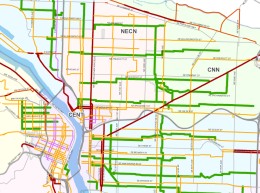
The Portland Bureau of Transportation has released an update on their 2012-2013 budget situation. As we suspected, a major shrinking of their budget has resulted in a restructuring of how the bureau will prioritize spending. In other big news, PBOT Director Tom Miller has unveiled a set of “organizational evolutions” that will change the face of the bureau.
As we’ve reported, PBOT faces a budget crisis of historic proportions. While all City bureaus are facing budget shortfalls, PBOT’s situation is especially bleak. Miller announced last month that he will reduce the agency’s General Transportation Revenue (GTR) budget by $16 million per year on an ongoing basis. When you consider that about $30 million of PBOT’s $100 million GTR budget is already committed, that’s a cut of about one-fifth of the total. In other words — an unprecedented contraction.
“I think the concept of [the Transportation] Options [Division] was probably provocative and compelling and progressive at the time of its inception; but I think it’s run its course. It’s time to re-invent that piece of the bureau. We will have an active transportation group within PBOT.”
— Tom Miller, Director of PBOT
Just to clarify, PBOT’s GTR budget is around $100 million (it was $107.5 million in FY 2011-12). Their total budget — which includes state and federal grants — is closer to $275 million. When we discuss this budget issue, we are only considering the GTR portion of the budget.
Last night at a meeting of the PBOT’s Budget Advisory Committee, Miller unveiled his plan to tackle the crisis.
In a message to the BAC, Miller wrote:
“When you have to cut as deeply as we do, you have to articulate priorities. In short, our approach is this: determine what the priorities are (e.g. functioning signals), where those priorities are most important (e.g. highest multimodal volume locations), and budget to maximize multimodal return on investment.”
To set the priorities, Miller is using a list of four criteria developed by the BAC (the committee also attached weighting to each criteria) and further refined by his own staff (download PDF of “Draft Budget Criteria”):
Each of the four criteria has been given a weight. Here’s the breakdown (note, the criteria is in draft form):
– Improves transportation safety (30%)
– Effective and efficient maintenance of Transportation’s assets (30%)
– Public health and livable communities (20%)
– Supports business and employment to promote economic vitality (20%)
Further refining the prioritization process, PBOT has assigned both a “substantive focus” and a “location focus” for each criterion. The substantive focus tells them how to spend the money and the location focus tells them where to spend the money.
With safety as a top priority, PBOT will first look to spend money on their “high crash corridors“. Also playing a prominent role in the location focus are what PBOT calls, “streets of citywide significance”. This is an important new term that will guide how PBOT prioritizes expenditures through the budget process for the foreseeable future.
Streets of citywide significance are defined as “streets that carry most of the multimodal volume”.
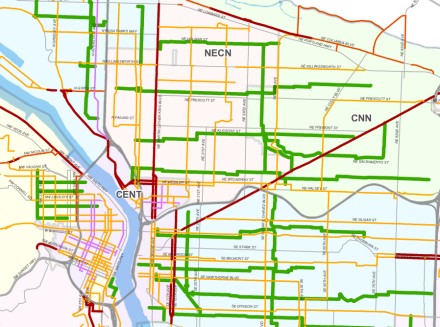
– Download PDF here –
“A dollar spent here [on a multimodal street], for example, would distribute limited resources more equitably than a dollar spent on a low volume, primarily single-use corridor,” reads Miller’s statement.
Put another way, Miller tells us, “The criteria tells us how the money will be spent, then the maps tell us where it goes.”
Sandy Boulevard is an example of a street that ranks very well under the new prioritization. Sandy is a major freight route, it carries frequent bus service, and it has a high volume of motor vehicles and people on foot.
What about bikes?
“For bikes,” Miller tells us, “we will treat the neighborhood greenway system as the streets of citywide significance.” While streets of citywide significance technically get first rank in priority, this new policy could actually make it more likely to see bikeway improvements on major arterials like Sandy. Here’s why: When you put spending through the priority “filters” of safety and multimodal transport, it’s possible that the formula favors adding bicycle access.
“It’s going to go through a series of filters to ensure we’re getting the dollars on the routes that are used by the most people in the city.”
— John Rist, PBOT business operations
Here’s a hypothetical: If PBOT had one dollar to spend, they’d take out 30 cents for safety. They’d prioritize reducing conflicts between modes (so a traffic signal — which is used by many modes — would score better, than say, a sidewalk repair project). Then, the first place they’d spend that 30 cents would be on a high crash corridor, after that they’d look to a street of citywide significance. The final filter would be vulnerable users, which they’ve listed out in priority order of: Safe routes to school, senior centers, community centers, and then neighborhood commercial districts.
John Rist, PBOT’s business operations manager says the new system gives them, “The ability to say to the public, as you work your way down of how you spend every dollar, it’s going to go through a series of filters to ensure we’re getting the dollars on the routes that are used by the most people in the city.”
One key reason Miller wants to adopt this methodology is to improve the transparency and public perception of how and where PBOT spends its money. “We’re trying to be specific so we can tell you, as a citizen, where that dollar goes and why it went there,” he said in a recent interview.

(Photo © J. Maus)
Miller — who took over as PBOT director less than one year ago — is also focused on a new push to make his agency more data-driven.
“We’re trying to be as data driven as possible… What we’re saying is, you apply the criteria that tells you how to spend the money than you look at the map and it tells you where to spend the money. You just work your way down the list and when you run out of money you’re done.”
This new approach is a major change from how PBOT has funded transportation in the past. It is much more specific and targeted to a given set of priorities; instead of being complaint driven and determined due to a process largely unknown to the public. PBOT has also adopted a four “guiding themes”: “equity; return on investment, minimum legal requirement, and revenue generation”.
In addition to the new budget priority process, Miller has announced a set of five significant structural changes to his organization. Below are the four initiatives he plans to advance:
1) A complete re-think of parking policy. Miller wants to consolidate all City parking functions under one roof. “Parking is an incredibly important piece of our revenue stream, but it’s managed in different parts of the agency… We need to speak with one voice.”
2) The Transportation Options Division (which promotes biking, walking, and taking transit and is behind popular programs like SmartTrips and Sunday Parkways) will be “re-invented”. Miller plans to create a new “active transportation group” that will be combined with PBOT’s planning functions. The goal, he says, is to “More explicitly call out the importance of the active transportation component of our mission and to make sure we are as focused there as we can be.”
Here’s more from Miller about the shifts coming to Options:
“I think the concept of Options was probably provocative and compelling and progressive at the time of its inception; but I think it’s run its course. It’s time to re-invent that piece of the bureau. We will have an active transportation group within PBOT.”
3) Improved asset management. This is part of Miller’s focus on data collection. An example he gives is tying priority of sidewalk repair with locations that see high transit boardings and de-boardings. “I want to know the condition of sidewalks that get people to and from those buses… With limited resources my sidewalks better be in best shape they can where boardings are highest… It’s about prioritization, and today, I can’t tell you that.”
4) PBOT will begin to monitor the condition of paint and thermoplastic that makes up much of the bikeway network. Miller says that unlike their ability to monitor pavement quality on major streets, PBOT has no system for tracking the condition of bike boxes, sharrows, or bike lane striping. “As a citizen, you ought to be able to know when we laid it [thermoplastic] down and when we need to refresh it. I can’t tell you that today. To me, that’s not appropriate.”
Miller sees bikeway thermoplastic and paint as a “hugely important” transportation asset. “A cyclist relies on that paint to provide a buffer between other modes. It says, this is my space, so stay out of it. If I’m not telling you how well we’re managing that asset I’m not doing my job as effectively as I need to.”
5) An outside review of PBOT business practices. Miller plans to hire a third-party company to take a look at PBOT’s internal processes and business practices.
This is a major announcement for Miller and by far the biggest step he’s taken since his tenure at PBOT began. He seems to be using the budget crisis as a way to enact some key reforms that he feels will not only address the funding shortfalls; but will also set a course for PBOT that will better serve his vision.
These initiatives, Miller feels, will also help the bureau overcome its current lack of public trust. Without the community on its side, Miller knows PBOT will be limited in its ability to go for the ultimate prize: a new, more stable and predictable source of ongoing revenue.
Mayor Adams has stated clearly that bureaus are not allowed to include new revenue sources in their budget plans; but that doesn’t mean Miller isn’t planning ahead. With dwindling gas tax revenues and a sluggish economy, it’s inevitable that PBOT will ask the public for new revenue. When they do, they’ll need as much trust as they can get.
Stay tuned for more coverage as the budget process unfolds.


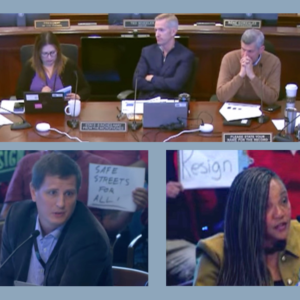
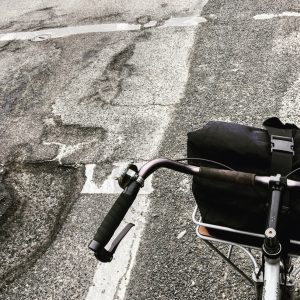

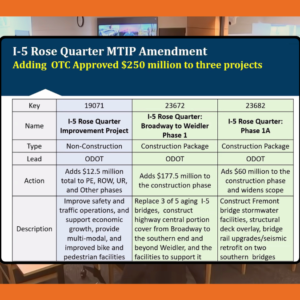
Thanks for reading.
BikePortland has served this community with independent community journalism since 2005. We rely on subscriptions from readers like you to survive. Your financial support is vital in keeping this valuable resource alive and well.
Please subscribe today to strengthen and expand our work.
Looks like East Portland will be remaining an auto-zone. 🙁
Hi Kathleen,
One thing to keep in mind is that this map is in “Draft” form and is subject to changes as the budget review process moves forward. Also, Miller made it clear that there will be a chance that streets beside those deemed “significant” could get projects done on them… Hawthorne Blvd for example could be an anomaly wherein it’s not on the map and it’s not a n’hood greenway, because it has a high volume of bike traffic it could get some attention.
So, while this new focus targets PBOT’s priorities, there is always politics and public pressure and other factors that could bump a project up.
God to know – I hope the city will consider investing a little in “deep SE” (i.e. within 82nd Avenue, but south of Powell – esp. south of Woodstock)
Also, the map looks like it has an error – I have a hard time believing that Lombard between Greeley and Albina has fewer than 75 buses per day, especially between Concord and Albina where the transit center sits.
Also, Sandy should be a street of interest out to 122nd – it still sees large amounts of commercial traffic out to that point, and commercial traffic = serious wear and long-term maintenance issues.
I wonder if, for south and east Portland (the area without many greenway miles), this becomes a way to formalize and perpetuate this imbalance. It also strikes me that areas with the _fewest_ multimodal trips might be worthy of the most attention, precisely to make them more multimodal. But this is just my first impression. Nice coverage, and I’m eager to read more.
Jonathan, Thanks for all your hard work in reporting this story. This really helps my studded tire initiative that saves roads from having to be replaced twice as soon because of studded tire damage to roads. To everyone, consider making a donation today, it’s politics.
preservingoregonroads.com
Of all the high crash corridors (Barbur, 82nd, 122nd, Foster) only 122nd and Foster are city owned streets. You’ll notice that 82nd and Barbur are not identified on the supplied map.
I don’t know about 122nd, but I saw this too and then realized that this map only shows City Owned arterials. Barbur is HWY 99W and owned by ODOT
If parking is such a large portion of their revenue, they should continue to expand the metered parking areas to include the parts of town where it can be ridiculously hard to find spots because they are free (around NW 23rd, for example). I don’t care if you are a resident or a visitor, you need to pay for the public resource that you are occupying with your private vehicle.
I’m glad that they are focusing on safety and maintenance. So many agencies including ODOT still believe that they can afford to expand roads and highways. We will not be able to afford this moving forward, we need to focus on maintenance and safety improvements.
And…start allocating parking space based on vehicle size. I can fit 4 of my car in 2 marked spaces downtown. I shouldn’t be subsidizing people who choose an 8 or 10 passenger vehicle as their primary transportation by paying for the excess parking space to be available to them. (Admittedly, there are car free people who are subsidizing my use of a motor vehicle when I choose to drive it, and I am in favor of a more equitable way to cover the cost of that use)
Came here for this: RAISE PARKING RATES!
plus expand the metered program to other business districts outside the downtown core
Tom has come up with some good ideas here, perhaps while riding his fixie.
But it is clear that automotive interests, with ODOT as proxy, still drive the system.
If I were in charge I would put the “final filter,” which is “vulnerable users,” in first place.
Evidently moving cars around still is far more important than getting children to school safely.
Many people believe that the safest way to get children to school is in the back of an SUV.
Keep me posted so I can update OpenCycleMap and verify that OCM’s data matches the city’s idea.
I would like to see streets with BIKE LANES- you know the BACKBONE of our bicycle transportation system called out as such! Vancouver/Williams, Broadway/Weidler. NE 12th, Naito Pkwy, and many others. Although they may not be the best streets to bike comfortably, they are used to connect to a lot of these lower stress routes. Lets make sure that they stay good and get better. Many of them are also transit corridors or freight streets, but don’t forget that narrow lane off to the right
Kind of funny when you stop and think about the focus on safety alongside the continued commitment to cars. Do we need to spell out how the one is threatened by the other?
The latter is on its way out, and acknowledging that more explicitly, recognizing and planning for this would go a long way toward helping on the safety front, not to mention being prudent, fiscally responsible, and a lot of other things. T
This framework on its own terms seems fine as far as it goes, but as others have pointed out it is still beholden to an autocentric mindset which is not helpful, not timely, not realistic, not safe. When are we going to have leaders who recognize that the end of the auto-dominance of our transport system is nigh, whether we wish that or not?
Pretending that we can hold onto our cars forever is not fiscally responsible. We should be able to do better, expect more foresight from our leaders.
Thanks Jonathan. This is interesting, but frustratingly vague, and I’m personally quite worried about any moves relating to Options, because I think they do a fantastic job. Which doesn’t mean that a change couldn’t be for the better, but you have to be careful when you are messing with success. Options is one of the programs that helps create the kind of multimodal efficiency that Miller is supposedly prioritizing. Their whole focus is transportation demand management: efficient use of the existing system, saving money, time, and pollution. So I don’t think it’s appropriate to say that it’s an idea that has run its course. More that it’s an idea that should be front and center, and so greater implementation and integration of the ideas throughout PBOT would be a good idea.
The other thing I find worrying, although sensible from one perspective, is the focus on highly-trafficked locations. This is definitely important for maintenance and improvements — invest limited $$ where they have the most impact — but it is not proactive, and it loses important factors about the potential or need in critical locations. If there’s not high foot traffic to a bus stop, that doesn’t necessarily mean there isn’t demand there. It might just mean that conditions are so poor that people are going elsewhere rather than do what would be the most convenient. Accounting for great need and latent demand is also a critical way to prioritize improvements.
(Time for me to email the budget address, clearly.)
based on the color coding, it would seem that the priority accorded to sandy derives from its use for transit (i.e., buses) and freight. willamette identified for transit only. similarly williams/vancouver, broadway, pieces of killingsworth, etc. greenways get their green but other bikeways get attention only because they are also carrying a lot of buses.
i don’t know exactly how tom miller will apply his multi-level filters, but based only on the words and the graphics, i can see bikes given a nod on any non-greenway street only in connection with multi-modal safety. miller’s statements about sidewalk repair is maybe a good clue here: i will fix a sidewalk near a bus stop, not otherwise.
question: does the 16m represent a proportional cut that is being made across the board at all bureaus, or is PBoT being shorted. if the latter, the city council needs to hear from anyone who has transportation issues in this town.
Cities in Oregon each get their share of state-collected gas tax revenues. Those can only be spent on roads. They don’t go to into a bucket with other revenues for City Council to dole out. As people drive less and use more efficient vehicles, cities, counties, and ODOT have less to spend on roads.
Everyone here seems to agree that much more money should be available for improving transportation, and someone other than us should pay for it. You could urge all your friends and neighbors to buy bigger cars and drive them more. The only problem is that the congestion, safety, and other costs they impose exceed what they pay in gas tax. A combination of VMT tax (tax per mile driven) and congestion charges could raise sufficient revenues in a more equitable way.
I apologize if this has been asked and answered elsewhere. Tom Miller states that parking is an important revenue source. There are many important commercial streets with absolutely free parking. Why not explore adding meters to streets with lots of commercial traffic- especially as a way to fund congestion relief projects (such as improved bicycle infrastructure)?
Bruce,
Miller isn’t talking any new revenue streams because of a clear directive from the Mayor. Adams has said he will not consider any new revenue streams at this time.
Thanks Jonathan. But…. are parking meters a “new revenue stream?” There are already meters in numerous locations. Why not put them everywhere (not residential) and democratically collect the $’s?
Would you like a meter in front of your house?
I would like a bioswale *and* a meter in front of my house.
Still Carless
thank you very much
word!
Was Carless: I specifically said “commercial streets.” It wouldn’t matter much if there was a meter in front of my house. My family has one car and when it’s parked it’s on the driveway. There is no such thing as free parking.
I lived for a year at 11th and Columbia. Having the meter was impetus to get up on weekend mornings and gave me a reason to walk somewhere when I’d otherwise sit all weekend, and made it easy to find a space on weekdays after work. I’m totally down with the streetside meter, even when not having the benefit of a rent-paid parking space adjacent.
There’s no such thing as a free lunch. Someone pays for every piece of parking lot in the city, whether on the street or by taxes. I pay for parking my car by paying rent on the house where I live. And I also pay taxes that subsidize people that park on the street.
YES!
Wow. We have billions of dollars to fight pointless wars on terror (I say pointless since you can’t win a war against an abstract noun), and no money for superficial stuff, like, oh say, schools and roads.
America sure has its priorities straight (aka it knows how to treat its citizens like sh*t).
Interesting. Sounds like they are prioritizing safety and non-auto modes of transportation well. Seems promising.
Am I seeing the map right? Zero Streets of Citywide Significance in the SW? Yuck
Get out your sharrows stencils, folks, because the city ain’t gonna do it for you.
Overall multimodal prioritization concept seems good — we do still need to move freight, buses and even cars around. But I do question my bike use only seems to factor into the draft map when we’re talking about neighborhood greenways. Arterials with bike lanes on them don’t seem to count, and that needs to be fixed.
Meant to say “I do question why bike use only seems to factor into …”